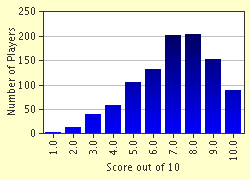Quiz Answer Key and Fun Facts
1. We have all heard of the Hubble space telescope. What was the first name of the astronomer with the last name Hubble?
2. What, in our solar system, is the Cassini Division?
3. The smaller, Earth-like, planets are called 'terrestrial' planets. What are the larger planets called?
4. Which moon of Saturn is known to have its own atmosphere?
5. The constellation 'Crux' is probably better known by which name?
6. Portions of the constellations Ursa Major and Ursa Minor are also known as what?
7. What is it called when we have a second full moon within one month?
8. The galaxy known as IRAS F10214+4724 is how many times brighter than the sun?
9. There are some scientists who believe that once the universe has ceased expanding, from the explosive repulse of the big bang, that it will begin to fall inward. The final moment of this falling inward has been termed what?
10. What was the name of the comet that made its closest approach to Earth on March 22, 1997?
Source: Author
thejazzkickazz
This quiz was reviewed by FunTrivia editor
crisw before going online.
Any errors found in FunTrivia content are routinely corrected through our feedback system.

